What Does It Mean When You License A Template Through Adobe
To generatecustom documents from response data, you must first ready a template for OpenForms to pipe that data into. These templates can be in Microsoft Word or Adobe PDF format.
This commodity describes when to utilize Adobe PDF templates, and how to ready them for upload to OpenForms.
From time to fourth dimension, working with Adobe Acrobat may require layout and formatting troubleshooting that tin do good from a proficiency of Adobe Acrobat or like design programs. If you have someone internally who is familiar with document templates, we recommend working with them. If you demand further assistance, refer to Adobe Acrobat'south assistance guide.
For data on preparing Microsoft Discussion templates, come across Format Microsoft Word templates for custom documents.
About PDF templates
PDF templates retain a consistent layout no affair how much data is piped into them. This is because response data is "painted" onto predefined areas.
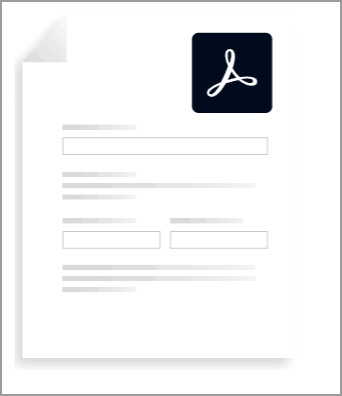
Response data will never exceed the space assigned to information technology by default. If a response is too long for the space it'south piped into, it volition exist resized to fit (every bit above). Depending on how yous've fix your PDF template, though, overflow text may be truncated.
This means that PDF templates are best suited to forms that receive predictable amounts of response information. (Though you lot tin can always impose a character limit on a text field to keep responses succinct).
When to use PDF templates
If your response data suits them, PDF templates offering extremely flexible layout and design options, pregnant that yous can generate custom documents using these templates that look exactly how you desire them to.
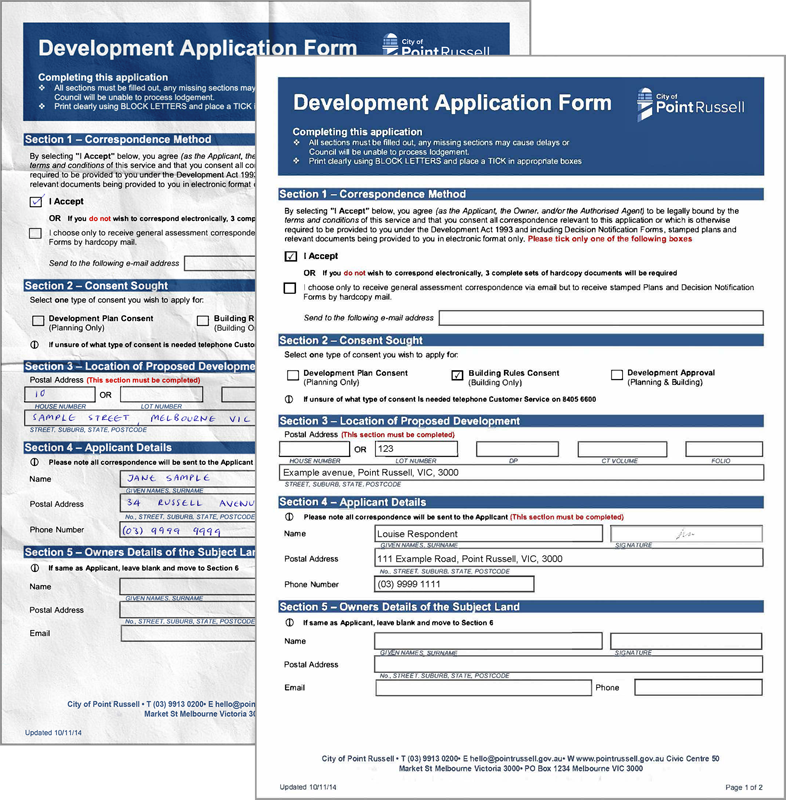
Ane mutual utilise case for PDF templates is generating custom documents that exactly lucifer your paper forms, as above.
By piping response data into custom documents that are identical to your existing paperwork (complete with checkboxes, piped signatures and and then on), y'all can file responses together no matter whether they've been nerveless through OpenForms, in person, or past mail service.
If you lot intend to use custom documents to file OpenForms responses alongside newspaper forms, information technology'due south worth noting that custom documents aren't an archival substitute for raw response data. Documents generated from PDF templates are flattened upon generation, so there's no lawmaking-level indication of what is template content and what is response data.
Of class, matching your newspaper forms isn't the only utilize case for PDF templates. Use these templates whenever you'd like your custom documents to be rigidly structured or carefully styled.
When not to use PDF templates
PDF templates aren't suited to forms that invite highly variable, potentially lengthy responses, every bit these can be difficult to read if they're scaled down too much, or fifty-fifty cutting off depending on your template settings.
Preparing PDF templates tin take longer than preparing an equivalent Word template, and y'all'll demand a licensed copy of Adobe Acrobat DC. If you're not too concerned about matching an exact layout or complying with strict design guidelines, you may find Word templates quicker and cheaper to make, while yet existence sufficient to your needs.
Set up a PDF template
To format a PDF template for OpenForms, follow these three basic steps:
-
Lay out your template
-
Add grade fields in Adobe Acrobat DC
-
Save your template in a supported PDF format
Step ane: Lay out your template
You tin can lay out your template in any program yous'd like, so long as you or your design team save the file in a format that Adobe Acrobat tin work with. Just brand sure to include all of the graphical and layout elements you'd like to use in your custom document, and leave infinite for OpenForms response data to be piped in.
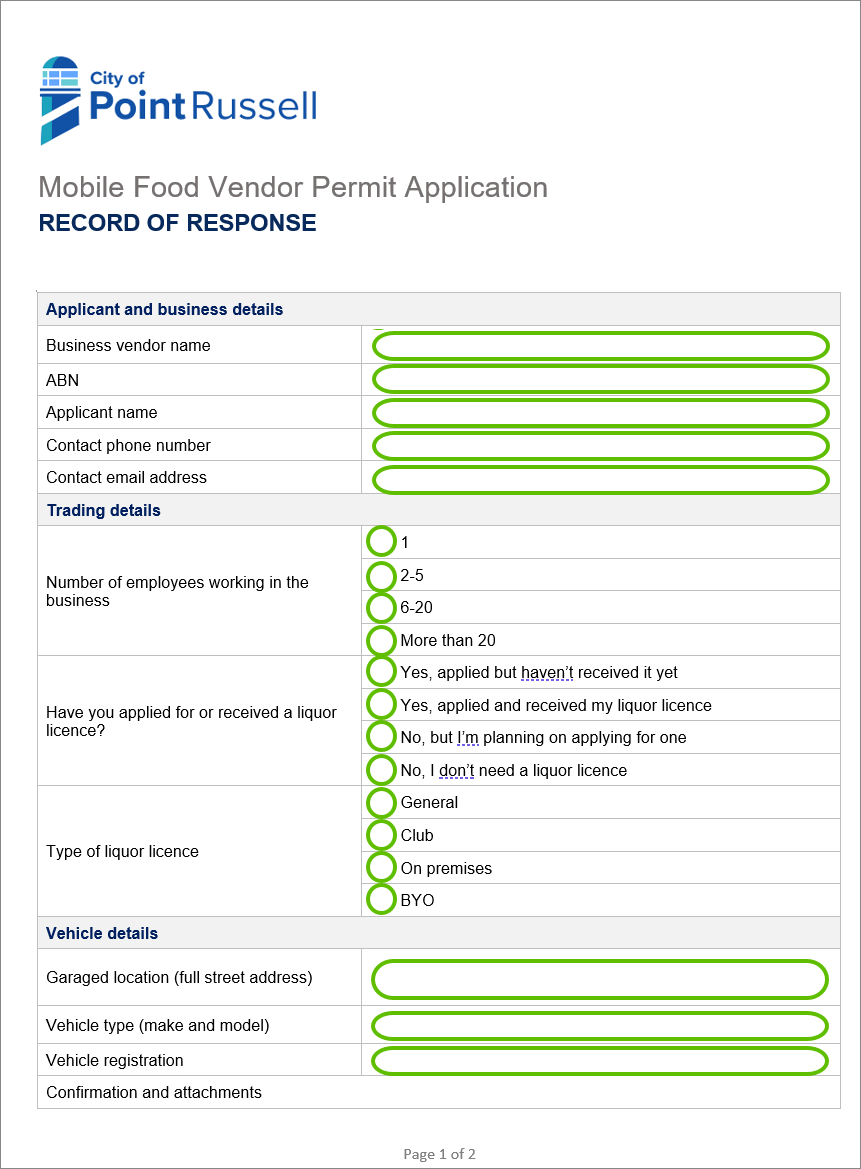
The PDF template higher up, for example, was actually created in Microsoft Give-and-take, but by formatting it in Adobe Acrobat, it can take advantage of features unique to PDF templates, such equally piping in checkbox and radio button selections as visual data rather than text, and maintaining a strict layout.
Make sure the person responsible for adding class fields to the template has access to whatever custom or paid fonts used in the initial layout, and has the appropriate font licences to embed these into a PDF.
Pace 2: Add form fields in Adobe Acrobat DC
Once your template is laid out, import it into Adobe Acrobat to designate where OpenForms will pipe response data into it.
To do this, yous'll demand a licensed copy of Adobe Acrobat DC(Standard or Pro).
Here's what to practice:
-
Open up your template file in Adobe Acrobat DC.
-
Get to Tools > Prepare Course.
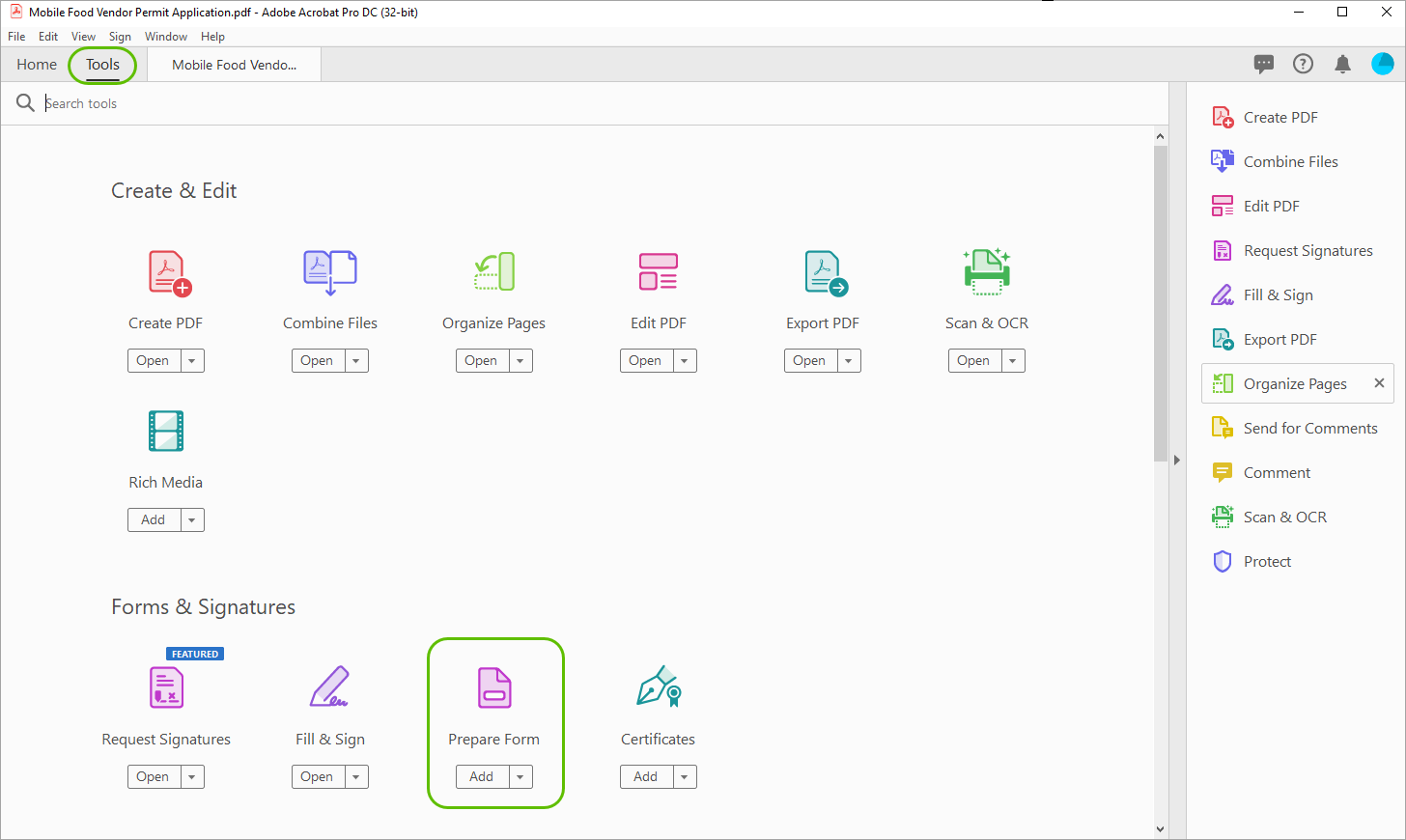
-
Uncheck This document requires signatures.
-
Leave Class field car detection on.
-
Select Start.
Adobe Acrobat volition endeavour to recognize the areas, or "fields", in your template file that information will exist piped into. This is typically quite successful, but y'all'll nevertheless need to fine melody your template past configuring the field properties, and calculation fields that Acrobat has missed.
(You may likewise have to delete some fields that Acrobat has wrongly added, to do this right-click a field and select Delete).
Adobe Acrobat fields that have OpenForms information
There are 5 types of Adobe Acrobat form fields that you can add to your template to receive OpenForms data:
- Text fields
- Dropdown fields
- Checkbox fields
- Radio button fields
- Image fields
Other Adobe Acrobat form fields such as Barcode and Button fields are unsupported. The type of field that is appropriate to your template depends on the kind of information you'd like to pipe in.
Text fields
The majority of OpenForms field responses are piped into PDF templates every bit text.
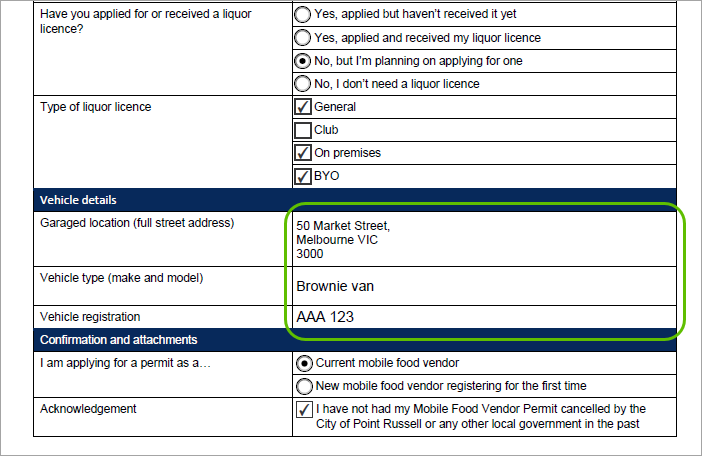
This ways that many of the fields you lot configure in your PDF template are likely to be text fields, even if they are configured as other fields (such as file upload, paradigm, or payment fields) in OpenForms.
For a full list of response data that is piped into custom documents as text, see What data can be piped into custom documents.
To insert a text field:
-
Select Add a Text field from the Prepare Form toolbar.

-
Use the Add a Text field cursor to select an area you'd like to pipe text information into.

-
Y'all'll exist prompted to name your text field - write something descriptive of the OpenForms field y'all'd like to pipe into your text field.
This doesn't have to be an exact match to your OpenForms field name, simply the more descriptive it is, the easier it will be to map your template fields in OpenForms later.
-
Echo the process for whatsoever additional text fields in your template.
Text field properties
Once you've added your text fields, you lot'll need to configure their properties. To do this:
-
Cull theSelect tool from the Prepare Form toolbar.

-
Select the text field y'all'd like to configure. If you'd like to apply the same settings to multiple form fields, you can select equally many equally you like by holding Shift equally you select them.

-
Double-click one of the text fields you have selected to open the Text Field Properties window.
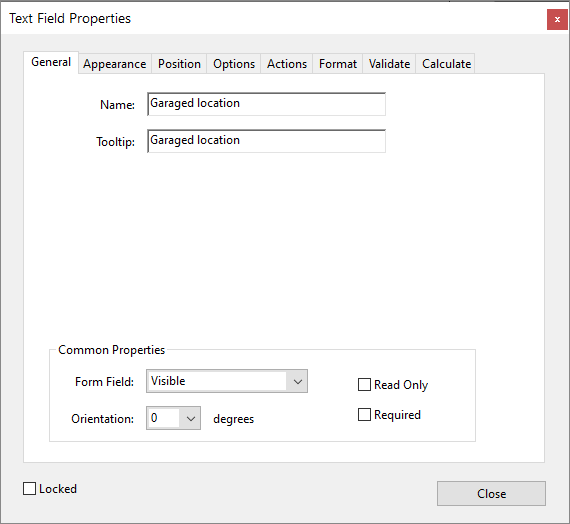
-
Go to the Appearance tab and set the font backdrop you'd similar to use.
Select a font size for text piped into the field. It'due south a good idea to select a size consistent with the rest of the text in your grade, otherwise Acrobat will scale upwardly any piped text to fit the text field you've created (which can look inconsistent with the rest of your layout).
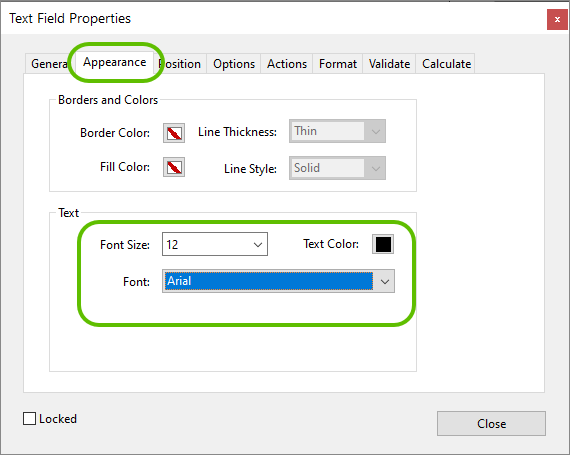
Even if you select a particular font size, if the response data OpenForms pipes in will not fit at this size, your text volition exist scaled down to fit unless you select Multi-Line rendering (see below). Border and color options in this tab will not be rendered past OpenForms, and then if yous'd like to have a border around text fields, yous'll need to add together this when laying out your template. -
Get to the Options tab and uncheck Coil long text.
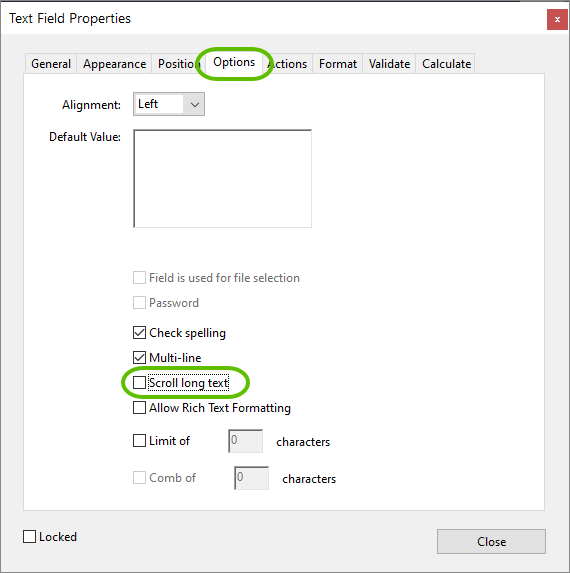
Leaving Scroll long text enabled can cut off piped text when custom documents are generated from your PDF template. This pick should always be off.In the Alignment dropdown, be sure to cheque and assign the alignment suitable for your template.
-
If y'all'd like to pipage in text data as multiple lines (as in the example below), check Multi-line.
Checking Multi-line will pipe form data in across multiple lines, and then long equally at that place is room in your text field. If the piped text is too long to fit the space provided, information technology will be cut off rather than scaled to fit. For this reason, it's of import to add a grapheme limit to whatsoever text fields in your OpenForm that you'd like to pipage into PDF template fields that use this choice.
-
Close the Text Field Properties window.
Dropdown fields
Adobe Acrobat dropdown fields can be used to pipage OpenForms dropdown selections into PDF templates.

Dropdown selections are piped in as text corresponding to a selection available in OpenForms.

To insert a dropdown field:
-
Select Add a dropdown list from the Prepare Form toolbar.

-
Use the Add a dropdown list cursor to select an area you'd like to piping a dropdown selection into.

-
You'll be prompted to name your field - write something descriptive of the OpenForms field you'd like to pipe in.

This doesn't have to be an exact friction match to your OpenForms field name, simply the more descriptive information technology is, the easier information technology volition be to map your template fields in OpenForms later. -
Echo the process for any boosted dropdown fields in your template.
Dropdown field backdrop
Once yous've added your dropdown list fields, you'll demand to configure their backdrop.
This step involves matching data in each dropdown'due south backdrop exactly to the answers in their corresponding OpenForms field, so you'll want to have your OpenForm open in another tab or window to cross reference your work.
To configure a dropdown field:
-
Double click on the dropdown list field yous'd like to configure. This volition open the Dropdown Properties window.
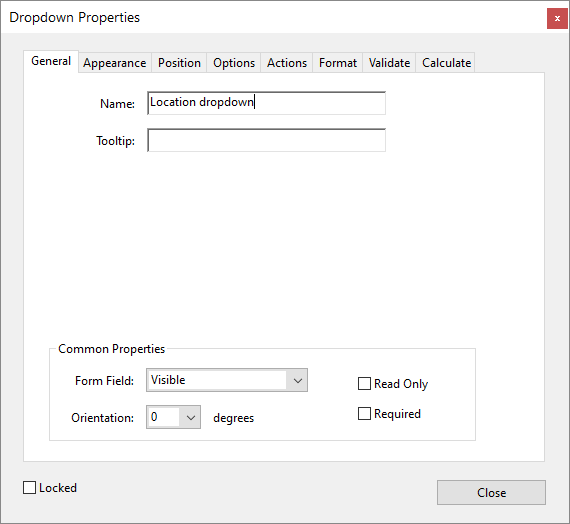
-
Become to the Appearance tab and gear up the font properties you lot'd like to use.
The font size y'all select will exist the font size for text piped into your dropdown field. If the response information OpenForms pipes in will not fit at this size, your text will be scaled down to fit.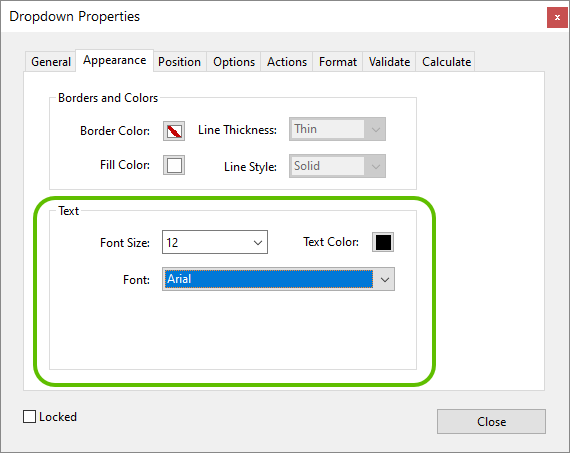
Border and colour options in this tab will not be rendered by OpenForms, then if y'all'd similar to have a edge effectually text fields, you'll demand to add this when laying out your template. -
Get to the Options tab and add each answer from your corresponding OpenForms dropdown field as an Item.
These values must match your OpenForms dropdown answers exactly, so you may want to re-create and paste them directly from your form.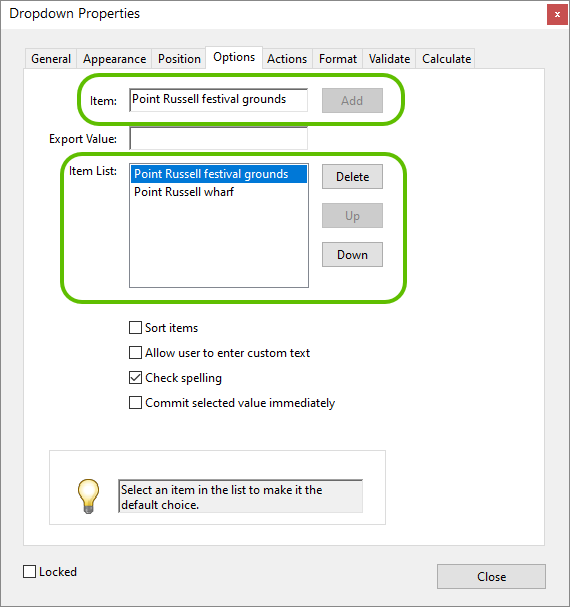
-
Keep adding Items until you've filled theItem list with all of the selections available in your OpenForms dropdown field.
-
Close the Dropdown Properties window.
Checkbox fields
Adobe Acrobat checkbox fields are used to pipe OpenForms checkbox selections into PDF templates.

Checkbox selections are piped into PDF templates every bit visual marks (like ticks, crosses, and so along) respective to a selection available in your OpenForm.
To insert a checkbox field:
-
Select Add checkboxes from the Prepare Form toolbar.

-
Use the Add together checkboxes cursor to select a checkbox you'd like to pipe a checkbox pick marking into.

-
You'll be prompted to name your field - write something descriptive of the OpenForms field yous'd like to pipe in and the checkbox answer you'd like to utilize.

This doesn't take to exist an exact lucifer to your OpenForms field name, but the more descriptive it is, the easier it will be to map your template fields in OpenForms after. -
Repeat the process for whatever additional checkboxes in your template.
Checkbox field properties
One time you've added your checkbox fields, you'll need to configure their properties.
This step involves matching data in each checkbox'southward properties exactly to their respective OpenForms selection, so you lot'll want to accept your OpenForm open in some other tab or window to cross reference your piece of work.
-
Double click on the checkbox field you'd similar to configure. This will open the Bank check Box Backdrop window.
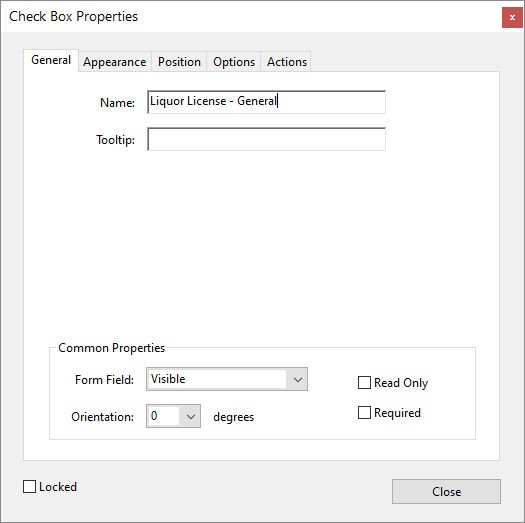
-
Go to the Options tab and select the Check Box Manner you'd similar to utilise.
Make sure this is consistent with the style for the rest of the possible checkbox selections for the answer y'all'd like to piping in.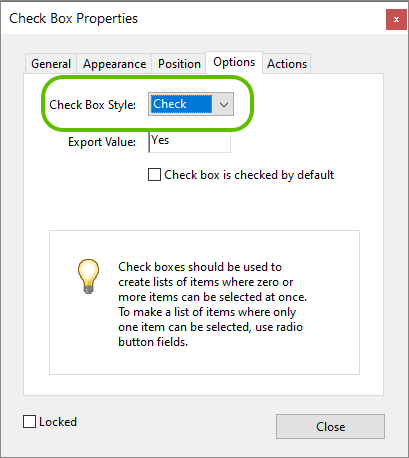
If your PDF Template contains a lot of checkboxes, you may want to select them all at once and apply a Check Box Style to them all earlier adjusting their individual settings. To practice this, select all the checkboxes you'd like to way, double click i, and select the appropriate way from the Options tab. -
In the Export Value field, insert the value for your respective OpenForms checkbox.
This value must match your OpenForms checkbox selection exactly, so you may desire to copy and paste it directly from your form.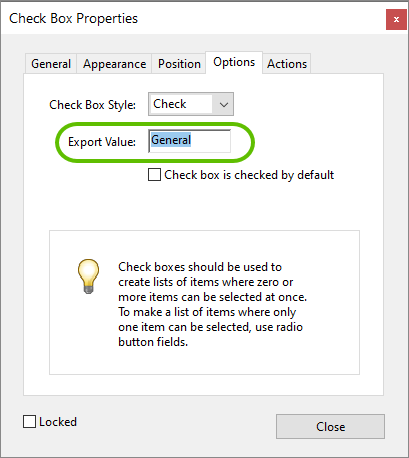
-
Close the Check Box Properties window.
-
Repeat this procedure for every checkbox in your PDF template.
-
You may desire toAlign your radio buttons after placing by selecting all your placed radio buttons and using theCorrect click > Align, Distribute or Centre menu.
Radio button fields
Adobe Acrobat radio push fields are used to pipe OpenForms radio button selections into custom documents.

Radio button selections are piped into PDF templates equally visual marks (similar ticks, crosses, then forth) corresponding to a pick available in your OpenForm.
-
Select Add together radio buttons from the Prepare Form toolbar.

-
Use the Add radio buttons cursor to select a radio button that you'd like to pipe a radio push selection mark into.
You'll be prompted to enter a radio push button Group name - write something descriptive of the OpenForms field you'd similar to pipe in.

This doesn't have to exist an exact match to your OpenForms field name, simply the more descriptive information technology is, the easier it will exist to map your template fields in OpenForms later.
In one case you have named your get-go radio push button in a group, y'all can select that name from a dropdown when placing subsequent radio buttons that correspond to the same OpenForms field. -
Repeat the process for any additional radio buttons in your template, being sure to give each group of buttons that correspond to a single OpenForms field a common name.
-
Y'all may want toMarshal your radio buttons afterward placing by selecting all your placed radio buttons and using theRight click > Align, Distribute or Center carte du jour.
Radio button field backdrop
Once you've added your radio push fields, you'll need to configure their properties.
This stride involves matching information in each radio button's properties exactly to their respective OpenForms option, and so you'll want to have your OpenForm open in some other tab or window to cross reference your work.
-
Double click on the radio push button field you'd like to configure. This will open up the Radio Button Properties window.

-
Go to the Options tab and select the Button Manner you'd like to employ.
Brand certain this is consistent with the way for the residue of your radio button group.
If your PDF Template contains a lot of radio buttons, you may desire to select them all at in one case and employ a Push button Style to them all before adjusting their individual settings. To do this, select all the radio buttons yous'd like to style, double click one, and select the advisable style from the Options tab. -
In the Radio Push Choice field, insert the value for your corresponding OpenForms radio button selection.
This value must match your OpenForms radio push choice exactly, so you may want to copy and paste information technology straight from your course.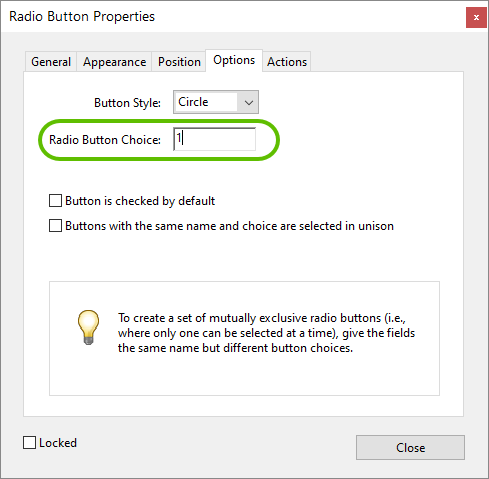
-
Close the Radio Push Backdrop window.
-
Repeat this process for every radio button in your PDF template.
Epitome fields
The simply images that can be piped into PDF templates are OpenForms signatures.

Images uploaded past form respondents using the file upload OpenForms field are piped in just like any other respondent upload: as a list of filenames.
To insert a signature image into a PDF template:
-
Select Add an Image Field from the Ready Form toolbar.

-
Apply the Add an Image Field cursor to select an area yous'd like to pipe a signature image into.

-
You'll be prompted to proper name your field - write something descriptive of the OpenForms signature field y'all'd like to piping in.
This doesn't have to exist an exact lucifer, but information technology helps to be as specific as possible.
Signature images and signatory names can both be piped into PDF templates as images and text, respectively, so information technology's a good idea to specify which signature data y'all're piping when naming these fields (epitome or name). -
Repeat the procedure for whatsoever additional signature images you lot'd like to pipe into your template.
In that location's no demand to configure any image field backdrop.
Step 3: Relieve your template in a supported format
In one case you lot've inserted and configured all of the fields you'd like to pipe OpenForms information into, information technology'south fourth dimension to save your PDF template and upload it to OpenForms.
Before saving, it's important to check your PDF'southward file properties to ensure it will piece of work with OpenForms.
Supported PDF Versions
OpenForms supports PDF templates exported using the following PDF versions:
one.two, 1.3, 1.4, one.5, 1.6, or 1.7
If yous're using an upwardly-to-appointment version of Adobe Acrobat DC equally role of a Artistic Cloud subscription, your PDF version should be well within the range OpenForms tin can work with.
To double cheque, go to File > Properties and check the PDF version in the Description tab.

Custom fonts
By default, Adobe Acrobat automatically embeds the fonts you've used in your template to ensure the file renders correctly. When you utilize the Save or Relieve As command, your fonts are embedded so long as they are available on your figurer and you take an advisable license to embed them.
Using Acrobat'south other export commands can give you more command over your PDF's embedded fonts, but also prevent OpenForms from piping in response data.
Some font licenses do non allow embedding into PDF documents. If you lot're using paid or custom fonts in your template, we recommend checking how the template renders on a device without those fonts installed afterwards you've created it. Font licensing is a complex area. If your organization uses paid or custom fonts, your blueprint team or brand manager should be able to tell y'all more virtually how to proceed.
Embedded fonts can significantly increment the size of PDF templates and the custom documents generated from them. If you generate a lot of custom documents from a template containing multiple embedded fonts, this can impact yourstorage quota.
Prepare to save?
If your PDF template uses the right PDF version and contains all the fonts recipients will need to view it, go ahead and s ave your PDF template
- Go to theFile menu and selectSave orSave As.
- If you are prompted to choose a save location, make sure you get outReduce File SizeandRestrict Editingunchecked.
Adobe Acrobat offers a big range of export options. Saving your PDF template using options other than the default "Salve" or "Save As" commands may flatten whatsoever fillable fields, preventing OpenForms from piping response data in.
What side by side?
-
Format Microsoft Word templates for custom documents
-
Upload your template and generate custom documents from response data
What Does It Mean When You License A Template Through Adobe,
Source: https://help.openforms.com/Create/Format-Adobe-PDF-templates-for-custom-documents
Posted by: hallmusenchently40.blogspot.com


0 Response to "What Does It Mean When You License A Template Through Adobe"
Post a Comment